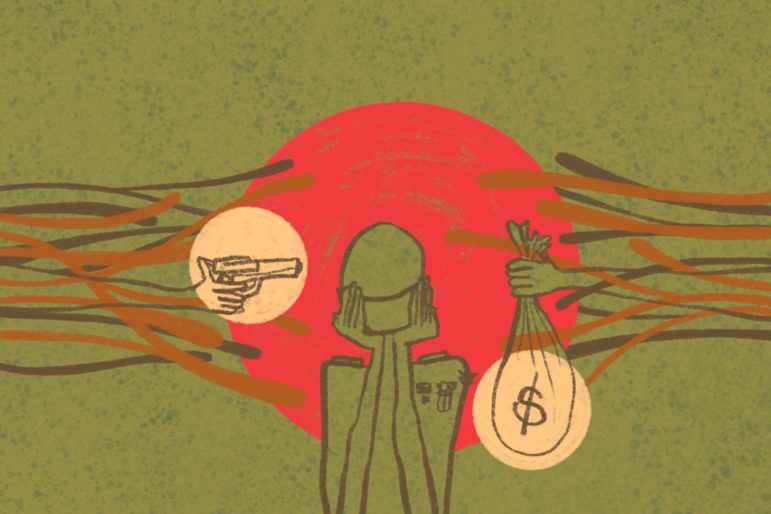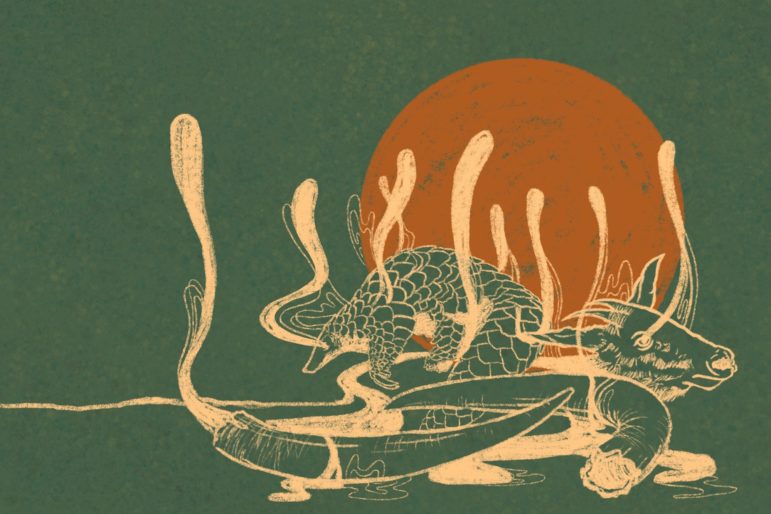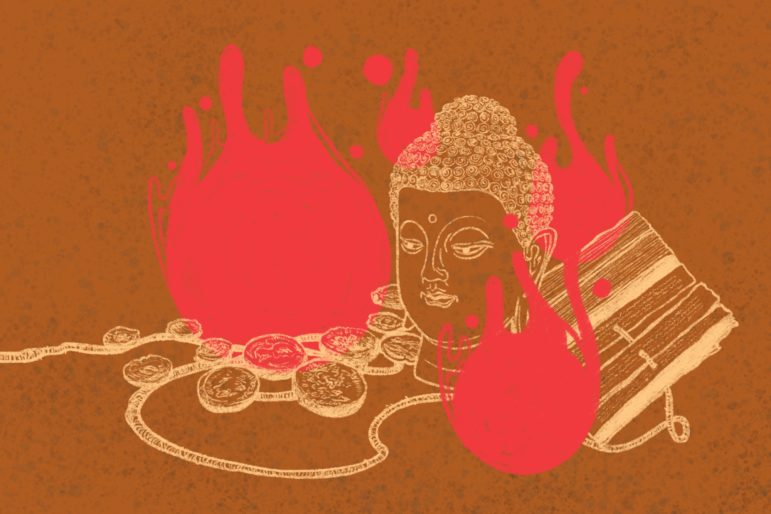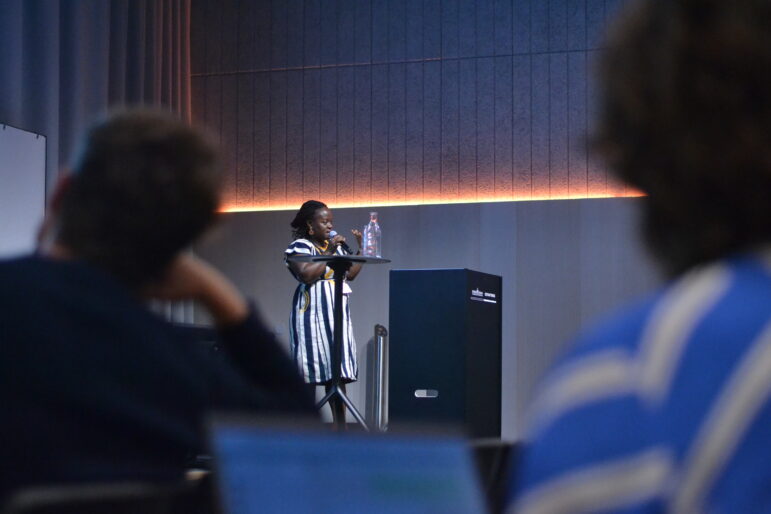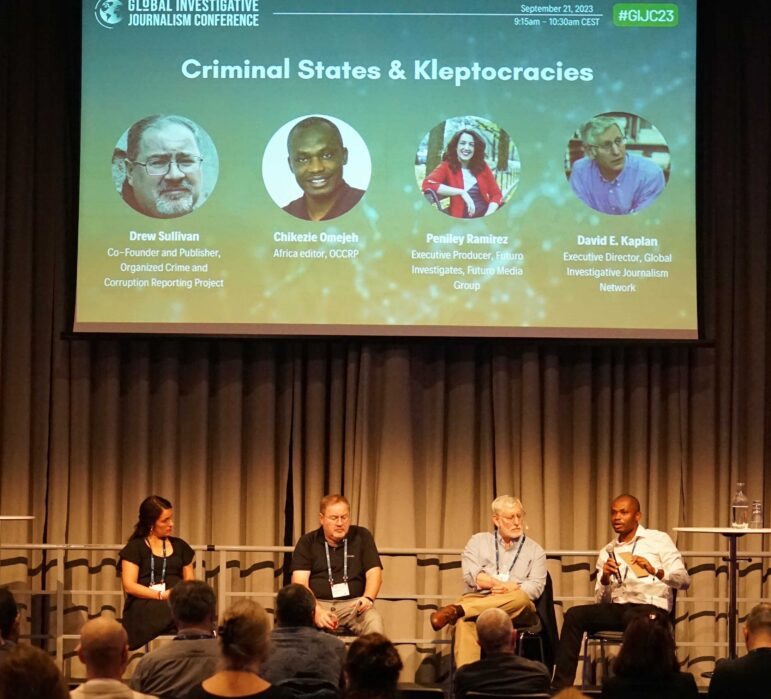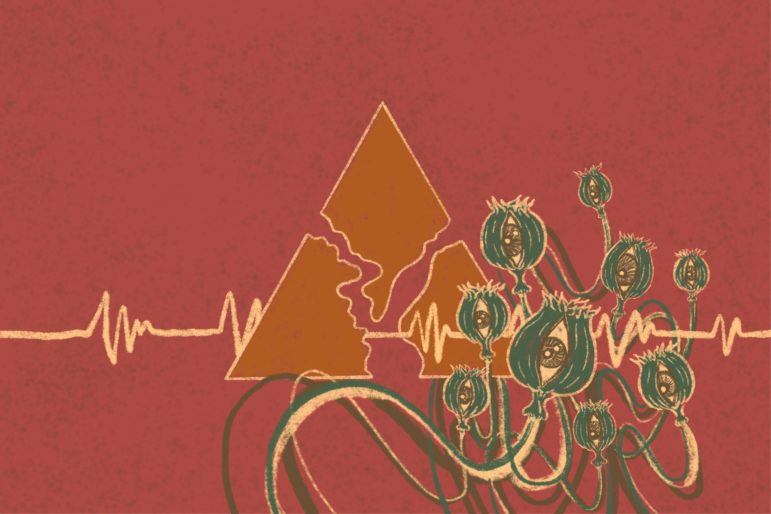

Illustration: CKJianan Liu for GIJN
Guide to Investigating Organized Crime in the Golden Triangle — Introduction
Chapter Guide Resource
Guide to Investigating Organized Crime in the Golden Triangle — Introduction
Chapter Guide Resource
Guide to Investigating Organized Crime in the Golden Triangle: Chapter 1 — Drug Trafficking
Chapter Guide Resource
Guide to Investigating Organized Crime in the Golden Triangle: Chapter 3 — Money Laundering
Chapter Guide Resource
Guide to Investigating Organized Crime in the Golden Triangle: Chapter 4 — Human Trafficking
Chapter Guide Resource Video
Video: Investigating Organized Crime in the Golden Triangle
There are three major myths about the Golden Triangle, where the borders of Myanmar, Thailand, and Laos intersect. The first concerns the name itself, which suggests that it has something to do with gold — perhaps because it has been used as payment for the drugs frequently exported from the area. The second is that Southeast Asia’s opium trade has deep historical roots and that poppies have been grown there for centuries. The third is that there is a battle going on between “bad guys” (traffickers and their criminal associates) and “good guys” (international and local law enforcement agencies doing their best to stop the trade and arrest the criminals who are behind it). On the ground, however, these distinctions aren’t clear-cut.
Contrary to popular belief, the Golden Triangle is not an old name for Southeast Asia’s opium growing region. It first appeared in print as recently as July 24, 1971 in a cover story titled “A Wonderland of Opium” for the now defunct Asia-wide weekly magazine the Far Eastern Economic Review. It was written by T.D. Allman, an American author, historian, and journalist, quoting then-US Assistant Secretary of State Marshall Green, who was saying that most opium was not grown in China, as Washington once claimed, but in a “golden triangle” stretching from northeastern Myanmar to northern Thailand and northwestern Laos. At the time, Washington was trying to win favor with Beijing and — coincident with Green’s statement and Allman’s article — it was announced that Nixon would visit China the following month.
Whatever the reason behind the term, it soon stuck, most likely because it captured the imagination of the public and evoked the lawless nature of the opium trade. Within a few years, the Golden Triangle — now with capital “G” and “T” — came to symbolize all of Southeast Asia’s narcotics-related problems. The name also caught on in Chinese (translated as jin sanjiao) and in Thai (samliam thongkham). It is easy to understand why. Only two currencies have remained constant in the area: narcotics and gold. In the past, heavily guarded mule convoys would take raw opium from the poppy fields in northern Myanmar to the border town of Tachilek opposite Mae Sai in Thailand, where most of it was sold to buyers from Thailand, Laos, and beyond, often in exchange for bars of pure gold. So gold was used to pay for opium, but that was not how and why the area got its name.
Since the Golden Triangle has no fixed borders and spans several countries, it is impossible to determine its exact size, but 200,000 square kilometers (about 77,220 square miles), or slightly smaller than the United Kingdom, would be a fair estimate. It is a rugged, mountainous area, and it is sparsely populated. No more than six to seven million people live there and they belong to ethnic minorities, mostly hill tribes but also some valley dwellers. The Myanmar portion of the Golden Triangle is by far the largest and the poorest, and that is also where most opium has always been grown. The Thai sector is very well-developed, now mostly urbanized, and no longer produces any opium. Laos is still an opium producer, but not to the same extent as before.

Approximate map of the “Golden Triangle,” encompassing the border regions of Myanmar, Thailand, and Laos. Image: Shutterstock
The hill peoples who grow opium in Myanmar today, or until quite recently, grew it in Thailand and Laos, live at an altitude where paddy cultivation is not practicable, which means that they have to depend on a cash crop to buy rice and other commodities from the lowlands. But contrary to popular belief, the opium poppy has not always been a major cash crop in the Golden Triangle, nor has the sale and consumption of opium always been illegal. Prior to World War II, all countries in Southeast Asia had government-controlled opium monopolies, not unlike tobacco and liquor monopolies today.
The British fought two Opium Wars against China in the 19th century, 1839-1842 and 1856-1860, which led to the acquisition of Hong Kong and the opening up of the Chinese market for opium from India. The British East India Company controlled vast poppy fields in Bengal — the eastern part of the Indian subcontinent, which today generally corresponds to Bangladesh and the Indian province of West Bengal — and other parts of the colony, as well as opium warehouses in Calcutta (now Kolkata), Bombay (now Mumbai), and other major cities in colonial India. In Burma, small quantities of opium — before World War II perhaps 30 tons or so per year — were grown in the highlands of the Shan States (parts of which now form the Myanmar sector of the Golden Triangle), and opium taxes produced some income for the Shan princes. The trade was strictly controlled by the colonial authorities under the 1910 Opium Act and later by the 1938 Opium Rules.
Siam (now Thailand) was never a European colony, but that did not mean that it escaped the scourge of the opium trade that had followed foreign rule in neighboring countries. In 1852, Siam’s King Mongkut (Rama IV), who had tried to ban the use of opium, bowed to British pressure and began importing vast quantities of the drug from India. Mongkut established a royal opium franchise which was “farmed out” to local entrepreneurs, mostly wealthy Chinese traders. Opium, lottery, gambling, and alcohol permits were up for grabs. By the end of the 19th century, taxes on these monopolies provided between 40 and 50 percent of Siam’s government revenue.
At an early stage, the French also turned to opium to finance their conquest of Indochina. Opium was imported to that region from Afghanistan and India, and the various French drug interests were consolidated under a single government-administered opium monopoly, a powerful agency called the Régie de l’opium. Profits soared and trade was brisk. By 1900, tax on opium accounted for more than half of all revenues in French Indochina. In 1930, the territory had 3,500 licensed opium dens, or one for every 1,500 adult males. The Dutch in the East Indies (now Indonesia) had a similar system and imported opium from Turkey and Persia (now Iran).
World War II not only altered the political map of Asia — India’s independence in 1947 eventually led to the end of colonial rule in the world’s most populous continent — but also had a dramatic impact on Southeast Asia’s opium trade. The war had meant that the sea routes from India and West Asia had become insecure, which prompted the French to encourage poppy cultivation in the highlands of northwestern Tonkin (now northwestern Vietnam) and Laos. Thailand, which had never been a major opium producer, also saw an increase in poppy cultivation in the north.
The old colonial opium monopolies were gradually abandoned. India continued its production of opium, but on a much-diminished scale and purely to produce morphine and other medicines for pharmaceutical use. Other uses were criminalized — at least officially. Corruption remained a major issue and domestic problems led to a dramatic increase in production, especially in Myanmar. The turning point was the invasion of parts of northern Myanmar by the Kuomintang (KMT), the Chinese Nationalists. Defeated in 1949 in China’s civil war, Nationalist Chinese forces retreated into remote areas of northeastern Myanmar, in which they set up a string of secret bases. The aim was to reconquer China from Mao Zedong’s Communists. The KMT’s involvement in the opium trade was openly explained by one of its most famous generals, Duan Xiwen (Tuan Shi-wen): “We have to continue to fight the evil of communism and to fight you must have an army, and an army must have guns, and to buy guns you must have money. In these mountains, the only money is opium.”
This statement prophetically described why so many other armed groups in the Shan States — resistance forces who took up arms against the central authorities in the late 1950s, as well as the Myanmar government’s own army and local militias — became involved in the complex politics of the Golden Triangle drug trade. The KMT persuaded the hill-tribe farmers to grow more opium and then the group introduced a hefty opium tax that forced local farmers to produce even more to make ends meet. By the mid-1950s, opium production in the Myanmar sector of the Golden Triangle had shot up 10-20 times, to an annual yield of 300 to 600 tons. The war in northern Myanmar also meant that it was too risky to bring traditional cash crops like tea or tobacco to lowland markets. Instead, it was now safer to grow opium because the traders would come to the villages and buy the raw product there.
Myanmar’s economy also collapsed following a military coup in 1962 and the introduction of a disastrous policy called the Burmese Way to Socialism. In order to fight Shan and other insurgents, Myanmar’s military ruler General Ne Win established local home guard units in 1963 called Ka Kwe Ye (KKY, “defense” in the Myanmar language). They were given the right to use all government-controlled roads and towns in Shan State for opium smuggling in exchange for fighting the rebels. By allowing them to trade in opium, the Myanmar government hoped that the KKY militias would be self-supporting; there was hardly any money in the central coffer in Yangon to support a sustained counter-insurgency campaign at this stage. Many KKY commanders became rich on the deal. The most infamous of the Golden Triangle’s drug lords, Lo Hsing-han (Luo Xinghan) and Zhang Qifu (Chang Chifu) — the latter commonly known by his alias Khun Sa — began their respective careers as government-allied KKY commanders: Lo in the opium-growing area of Kokang, and Khun Sa on the opium mountain of Loi Maw near the Myanmar army’s garrison town of Tang-yan.

Map showing illicit crop cultivation in northeast Myanmar and northern Laos in the Golden Triangle region, circa 2016. Image: UNODC
Today, the Golden Triangle’s opium production has declined considerably as the demand for opium and its derivative, heroin, has declined in the region and worldwide. But that has affected only the poor hill-tribe farmers who grew the poppies and have lost their incomes; the drug lords have instead turned to the production of methamphetamines (referred to locally as ya ba, Thai for “madness medicine”) and other synthetic drugs, for which only chemicals are needed and there is a new and ready market. The general lawlessness of, in particular, the Myanmar sector of the Golden Triangle has also made it a center for other illegal activities, such as people smuggling, trade in wildlife, rare earth mining, and antiquities trafficking. Guns, some rather sophisticated, are produced in factories and workshops in the Golden Triangle and sold to rebels as well as criminals in Southeast and South Asia. At least 20 casinos have also been built in northern Laos and along Myanmar’s borders with Thailand, which serve as vehicles for money laundering.
In other words, the Golden Triangle remains one of the world’s great centers for all kinds of illegal activities. The hidden, black economy in the area and its spin-offs run into billions of US dollars annually.
In the Golden Triangle there is, supposedly, a “war on drugs,” a term popularized by the media after a press conference given by then-President Richard Nixon in June 1971 during which he declared drug abuse “public enemy number one.” And that war is still being fought.
But the war on drugs in this region is not as clear-cut as international agencies want the outside world to believe. Myanmar’s ethnic insurgency as well as the government’s counter-insurgency campaigns have always been closely connected with the narcotics trade. The KKY were abolished in 1973, but new, government-recognized militias called pyi thu sit (“people’s militia”) have taken their place, running a wide variety of officially sanctioned criminal activities. Rampant corruption is also widespread within law enforcement agencies in Myanmar, Thailand, and Laos — and it is precisely with those local entities that international law enforcement groups and United Nations agencies have to cooperate. Therefore, official complicity in the trade is rarely mentioned in reports compiled by foreign law enforcement agencies and never by the United Nations Office for Drugs and Crime (UNODC).
Furthermore, the pioneers in the Golden Triangle opium trade, the KMT, operated closely with US, Thai, and Taiwanese spy agencies, which turned a blind eye to the KMT’s officially illicit activities as long as they proved to be useful intelligence assets. Today — and for the same reasons — China has cordial relations with Golden Triangle drug traffickers. The final outcome of the “war on drugs” is that those who get caught are mostly couriers who carry the drugs from one place to another — and who can be easily replaced. Big traders seldom get caught or, if they are, they manage to strike deals with governments. Lo Hsing-han and Khun Sa ended their days as wealthy businessmen, living in luxury in the old capital Yangon.
For decades, the Golden Triangle has drawn journalists from around the world, attracted by the region’s illicit markets, its rich history, and fascinating cultures. Through the lens of a crime reporter, the region offers an extraordinary array of stories. But journalists should approach such stories with a healthy degree of skepticism, as facts on underworld markets can be hard to come by. A few suggestions to keep in mind:
It is important to study the historical background when writing about the trade in drugs and other commodities in the Golden Triangle. It is never as clear-cut as many may believe. It involves many different actors, legal as well as illegal and some in-between, and journalists should proceed with utmost care, objectivity and without sensationalizing the issues. Finally, many of the local players are seen as perfectly respectable businesspeople or government officials in their home countries, who could be litigious if their reputation is sullied by an exposé. As a result, legal risks must be taken into consideration, and any major story should be vetted by lawyers prior to publication.
Additional Resources
Reporter’s Guide to Investigating Organized Crime
Journalist’s Guide to Investigating Drug Trafficking
Tips for Reporting on Human Trafficking and Forced Labor
 Bertil Lintner is the author of 22 books on Asian history, politics and crime. He is currently with Asia Times and a former correspondent with the Far Eastern Economic Review, the Swedish daily Svenska Dagbladet, and Jane’s Information Group in the UK. Lintner lives with his family in Chiang Mai, northern Thailand.
Bertil Lintner is the author of 22 books on Asian history, politics and crime. He is currently with Asia Times and a former correspondent with the Far Eastern Economic Review, the Swedish daily Svenska Dagbladet, and Jane’s Information Group in the UK. Lintner lives with his family in Chiang Mai, northern Thailand.


